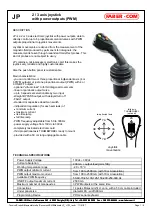
43
Loop Break Time - the time interval from when the controller detects a loop
break condition and the initiation of the failsafe state.
Lowest Reading - records the lowest process value read by the controller. May
be reset to zero by using the Raise or Lower arrow keys.
Lower Setpoint Limit - prohibits users from adjusting the setpoint lower than
the selected value.
Manual Reset - an adjustment that moves the Proportional Band up or down by
a fixed percentage so that more or less power is applied at setpoint. It is used
to eliminate offset error.
On/Off Output Type - In a heating application, the controller applies 100%
output power if the process temperature is below the setpoint and 0% at the
setpoint. For a cooling application, the controller applies 100% output power if
the process temperature is above the setpoint and 0% output power at the
setpoint. There are only two output states: fully on and fully off.
Applications for On/Off Control:
1. When temperature oscillation is acceptable.
2. When constant cycling of mechanical devices is
prohibited (Compressors, Blowers, etc.)
3. Under-powered processes
Output Low Limit % - Prohibits the controller’s output from going
below the specified percentage.
Output High Limit % - Prohibits the controller’s output from going above the
specified percentage.
PID Output Type (Proportional - Integral - Derivative) - The controller
modulates output power by adjusting the output power percentage within a
proportional band. Power is proportionally reduced as the process temperature
gets closer to the setpoint temperature. PID control helps reduce overshoot on
start-up, enhances stability, and compensates for process lag. The PID
parameters are automatically calculated for a particular application during the
autotune procedure.
Applications for PID Control:
1. Where process temperature lags exist
2. When load changes are present
3. When overshoot is prohibited
4. When very accurate control is required
Proportional Band - the band (expressed in degrees of temperature) in which
the controller modulates its power percentage.
Temperature Lag - The product of thermal resistance and thermal capacity.
Also defined as delay of the transmission of heat from the controlled element
to the sensor caused by thermal mass of the process material and/or process
container, or the distance between the control element and the sensor.
Upper Setpoint Limit - prohibits users from adjusting the setpoint higher than
the selected value.
42
Alarm Delay - the time delay between the detection of the alarm condition and
the initiation and indication of the output action.
Alarm Inhibit - prevents low setpoint alarm activation during cold startup
applications.
Bias - allows the operator to compensate for any difference between sensor
temperature and the point to be measured. The process display and setpoint
will be offset by the value entered in the Bias parameter in the input menu. Ex:
Desired temperature is 150 degrees. Sensor is adjacent to heater and reads 50
degrees higher than the actual process temperature. Enter bias of -50. Enter
setpoint of 150. Process will display 150 even though sensor will be
measuring 200 degrees.
Blanking - controls the time the setpoint value display remains on. After the set
time, the setpoint value display turns off. Pressing any button causes the
setpoint value display to reappear for the selected time interval.
Cycle Time - The period of time in which the controller’s output completes an
on-off cycle (Proportional Output Type only).
Example: Output type = Mechanical relay
Cycle time = 10 seconds
Output power = 50%
Controller output = 5 seconds closed,
5 seconds open
Deadband - In On/Off temperature control, it is the band above or below the
setpoint where there is no output action. It has the effect of moving the
apparent setpoint.
Derivative (rate) - Adjusts the controller gain quickly in response to load
changes.
Failsafe State - designates the percentage of power output that the controller
defaults to after it detects a loop break condition and after the loop break time
has elapsed.
Filter (in Display menu) - changes the filtering speed for the process value
display only. It does not affect control. This parameter is mainly used to slow
down the flickering of the display when the decimal position chosen is greater
than zero.
Filtering (in Input menu) - sets the time period over which the process value is
averaged.
Highest Reading - records the highest process value read by the controller. It
may be reset to zero by using the Raise or Lower arrow keys.
Hysteresis - In On/Off temperature control, hysteresis represents the band
where the output changes state from deactivated to activated. It prevents
chattering around the setpoint and prevents rapid output cycling.
Integral (automatic reset) - slowly adjusts the position of the Proportional
Band (range of power output) to eliminate offset error.
Loop Break - a condition where the input is not changing or responding
properly to the output action. This could be caused by a thermocouple or input
failure, or a heater or load failure.
Glossary
Glossary



































